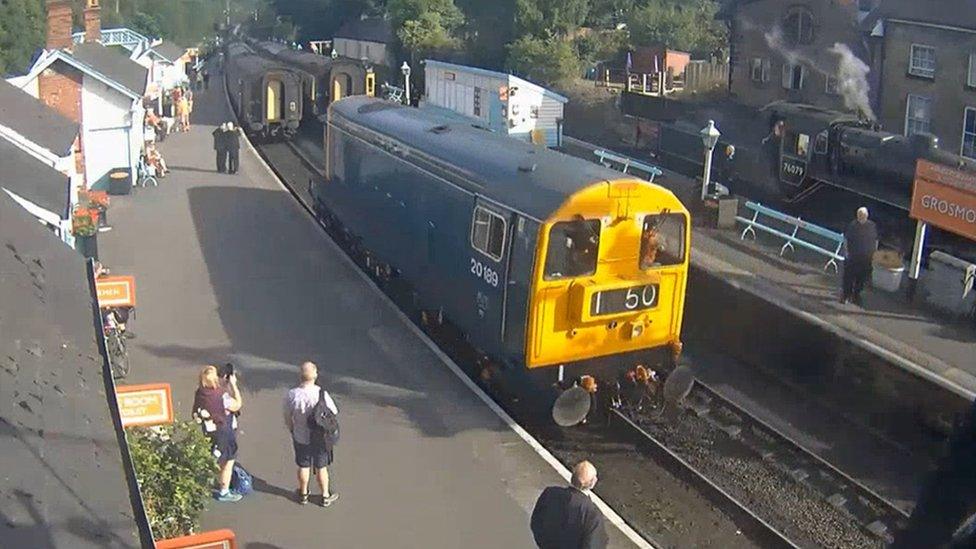Grosmont rail crash due to speed and poor visibility
- Published

The locomotive entering platform two, just before the collision
Excess speed and poor visibility led to a diesel locomotive colliding with a passenger train, an investigation has concluded.
Five passengers sustained minor injuries in the crash at Grosmont Station on the North Yorkshire Moors Railway (NYMR) on 21 September.
The Rail Accident Investigation Branch (RAIB) said the locomotive had intended to stop behind the waiting train.
Instead it hit the rear of the train at about 5mph (8km/h).
The RAIB report, external said the locomotive was travelling too fast to be able to stop in the distance available when the driver realised he was too close to the rear of the waiting train.
The class 20 locomotive, designed in the 1950s, only has a cab at one end, which can restrict a driver's visibility of the line ahead when the nose end is leading.
The report said the class 20 unit had been made available to the heritage railway while some of its own locomotives were undergoing maintenance and was brought into use at short notice on that day after a steam locomotive failed an operational test.
Although qualified to drive the steam locomotive, the RAIB said, the driver did not have a specific competency to drive the class 20.
He had asked to be accompanied by a traction inspector.
The class 20 had already driven to Whitby that morning and then returned to Grosmont, where it was uncoupled from the train and replaced with a steam locomotive.
As it would be required for a later journey to Whitby it was agreed it would be stabled in a siding until it could be coupled to the later service.
A train was already waiting for departure on platform two, blocking access to the siding, and the class 20 was advised to wait in the free space behind the Whitby-bound service and, once it had left, move into the siding.
"The driver undertook the move from platform three to a position behind signal 11 with the locomotive's cab leading," the report stated.
He then changed driving desks and began the move back towards platform two with the cab end trailing and increased his speed to around 10 mph (16 km/h).

The image shows the diver's view of the line ahead from cab-leading and cab-trailing positions
The initial part of the move was on a straight line, with the driver's view of the line limited by the body of the locomotive ahead of him, the line later curves to the right, further limiting his view.
RAIB said he would have only been able to see the rear passenger coaches when he was 16m (52ft) away.
The report found the driver did apply brakes and the emergency braking slowed the speed to 5mph, but the decrease in speed began when the carriages were only 20m (65ft) away.
The driver stated he believed the train was further along the platform and he had more time and space.
The RAIB concluded his unfamiliarity with the engine was a contributory factor to the collision.
The Office or Rail and Road issued the NYMR with an improvement notice in October due to the collision.
It requires the railway to be able to demonstrate the competence of its drivers for operation on both its own infrastructure and on Network Rail's line.

Follow BBC Yorkshire on Facebook, external, Twitter, external and Instagram, external. Send your story ideas to yorkslincs.news@bbc.co.uk, external